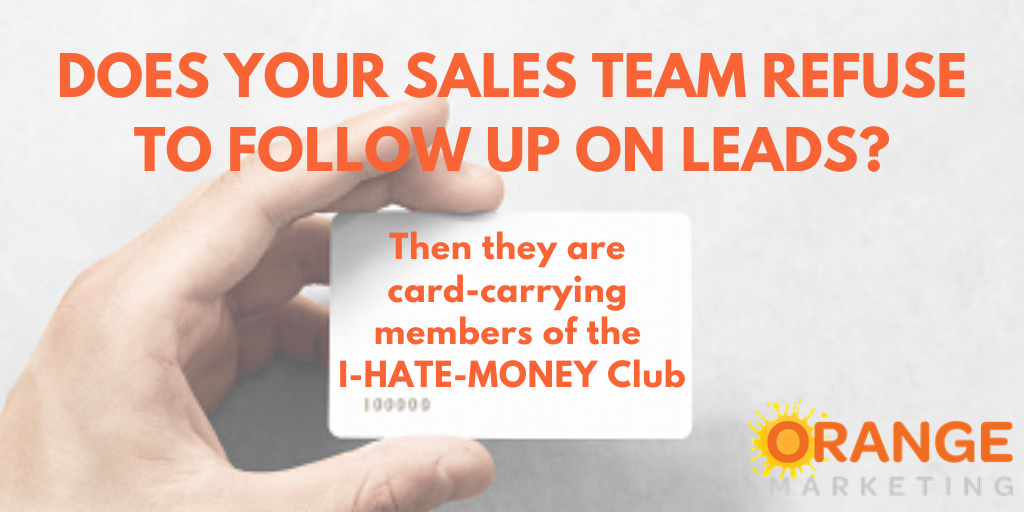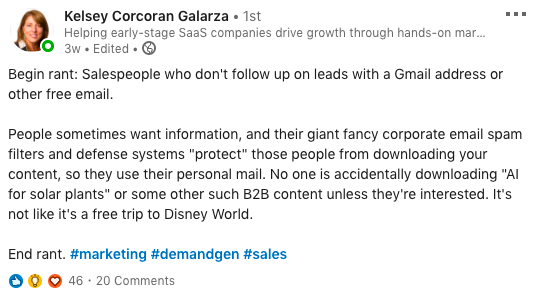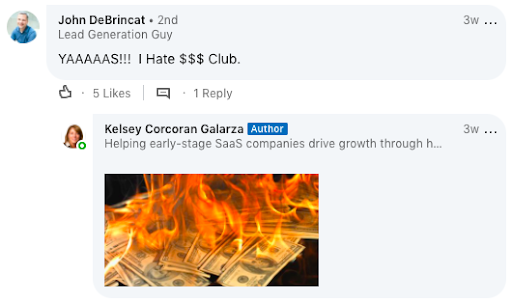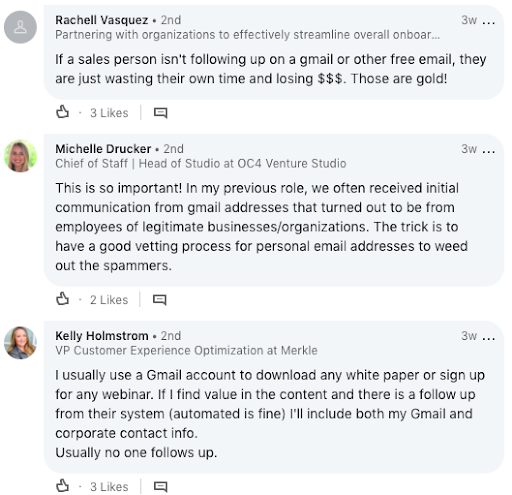
One of the #1 cries marketing teams are familiar with hearing from sales teams is, "Need more leads!" And Marketing responds by launching an expensive inbound content and paid marketing strategy.
In a twist of irony, it's not long before Sales proclaims, "Too many leads!"
Because content marketing is a top-of-funnel activity and all about providing relevant information to anyone digging around the internet in exchange for their email address, there are inevitably going to be some downloads from people who aren't potential prospects.
This presents a new conundrum: salespeople who then start believing, "These leads suck!" and in the interest of saving their own time and energy, may try to qualify the leads without ever following up.
Sales teams prefer corporate emails. (Well, duh.)
One of the ways we have seen sales teams determine which leads are not worth their time, is by judging the lead's quality by its email domain. Here are some actual responses we have received about marketing qualified leads from salespeople:- "I can't offer any insight as they have a Gmail address."
- "I tend not to pay any attention to anyone who leaves a Gmail address."
- "Used a Gmail account. Not a lead."
- "We should block generic email addresses like Gmail."
- "I don't call Gmail."
We get it.
Any salesperson would prefer to obtain a business email versus an email from a free email service. A corporate email address gives sales advantages like being able to research the company and even the job title of the lead within the company via LinkedIn or elsewhere. This makes things easier for a salesperson and allows them to provide more value to the prospect in messaging or a demo experience that can be catered to a person or company they know something about. Realistically, not everyone is willing to provide their super-top-secret business email when they're first exploring solution options.
Why do people use personal email when filling out B2B lead forms?
There are several reasons why a person may enter a Gmail or other free email address instead of their corporate email address on
"contact-us" and "download content" forms. Here are a few:
- They have a fancy corporate Outlook, which blocks nearly every type of promotional email, and your prospect is actually trying to get the email with the PDF of the downloadable content.
- Their computer or device auto-filled their personal email, and they didn't notice.
- They entered their personal email address out of habit and didn't intend to.
- They don't like to use their corporate email when requesting information from vendors because they aren't ready to talk to a salesperson.
- They are a competitor or a Russian spy.
- AND last but not least, your marketing team is doing paid advertising (spending money) on LinkedIn and Google ads which use native form fills (within the application), and LinkedIn/Google AUTO populate the prospect's email. And 90 times out of 100, this is a personal email.
- They insist marketing excludes free email addresses from being able to submit on the form. In HubSpot, this can be done by checking a box on the form, "Block free email providers."

- Instead of arguing with marketing about blocking free email providers, the sales team members self-select and simply don't follow up. At all.
I-Hate-Money Club
Honestly, we have this conversation about once a quarter, and after one such interaction, we vented on LinkedIn:

And here are some of the responses:



We certainly felt better.
Real-life example I-Hate-Money Club
Let's look at a real-life example of why Gmail leads are worth the time.
A client's sales rep made a habit of completely ignoring leads with Gmail addresses. Despite our efforts to convince the Account Executive (AE) otherwise, she continued to disregard.
It's relatively easy to find people on the internet these days, and one day, out of curiosity, a quick LinkedIn search on a particular inbound Gmail address led us to discover a large Japanese toy manufacturer who was a real prospect for our client's product. When we let our salesperson know the contact was a high-profile lead, the response was, "but he used a Gmail account." This is a commissioned sales rep. 🤔
About a year later, this same company hired a Sales Development Rep (SDR), who followed up on all past leads in the database and was paid to set appointments for the AE. It wasn't long after making contact with our original toy manufacturer "Gmail address, not a lead" contact, that we watched our new SDR change the contact’s HubSpot Lifecycle Stage to "Opportunity."
Too many leads? So what is the solution?
We implore you:
- Do not block people who use free email domains from filling out your forms, even if your CRM provides this “feature.”
- Do not ignore people with free email domains who have filled out your forms. Follow-up with emails and phone calls (7-10 touches).
- But consider, prioritizing free email domains differently in terms of HOW you follow up with them.
Use HubSpot Sequences to automate Nurturing Leads
Using HubSpot Sequences to automate outreach is an effective tool to find, nurture, and close leads. Automating outreach ensures that even prospects who are perceived as low-quality leads are still followed up with, while not adding to the administrative burdens of salespeople. An automated follow-up process with an email directly from the salesperson on initial engagement is an effective way to nurture a lead without pressure. This increases the productivity of salespeople by affording them the luxury of only spending time on engaged leads.
Our preferred method of following up with Gmail email address submissions is to enroll these contacts into a string of nurture emails. This does not have to be over complicated and the content can simply be collateral or even blog posts that already exist. Marketing 101 will tell you it takes 7-10 touches before a conversation with a lead happens. Remaining consistent with communication on all leads, even via automated email outreach, prevents any from falling through the cracks.
I-Love-Money Club!

In conclusion, we beg you, stop underestimating who is on the other end of that Gmail address and you may find yourself pleasantly surprised.
And the next time we run across this very situation with a sales team, instead of rolling our eyes and getting angry-sarcastic, we will simply send them a link to this blog post. After that, it’s on them.